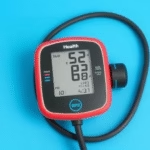We will be talking about how to find the brachial pulse for blood pressure.
The brachial pulse is an important aspect of monitoring blood pressure and understanding cardiovascular health. The brachial artery runs along the inside of the arm and is accessible for palpation, making it a key location to measure your blood pressure. The ability to locate the brachial pulse accurately is essential for healthcare professionals and individuals alike, as it allows for the assessment of blood flow and circulatory function. Detecting the brachial pulse is especially crucial when using a blood pressure cuff to measure blood pressure accurately, as this ensures that the readings reflect true physiological conditions. In essence, locating the brachial pulse is not just about feeling for a heartbeat in the arm; it also serves as a gateway for understanding your cardiovascular system’s health and functionality. This foundational knowledge is essential for maintaining optimal health and taking proactive measures against potential health complications.
1. Understanding the Anatomy of the Brachial Artery
To effectively find the brachial pulse, it’s vital to understand the anatomy of the brachial artery. The brachial artery is a major blood vessel that supplies blood to the arms and hands. It begins in the upper arm when the axillary artery transitions into the brachial artery and runs down toward the elbow. It branches off into the radial and ulnar arteries at the cubital fossa, located near the elbow joint. Knowing the route of the brachial artery can aid in locating the pulse accurately.
Additionally, being aware of the surrounding structures, including muscles, nerves, and other blood vessels, also helps healthcare professionals avoid potential complications during blood pressure assessments. When measuring blood pressure, the cuff is placed around the upper arm, compressing the brachial artery until blood flow is restricted. As the cuff pressure decreases, the healthcare provider listens for the sounds of blood flow through the brachial artery using a stethoscope. Understanding this entire process requires an appreciation of the anatomical layout and function of the brachial artery and its relevance to blood pressure monitoring.
2. Techniques for Locating the Brachial Pulse
Finding the brachial pulse requires a systematic approach. First, you’ll want to have the individual sit or lie down comfortably. Place your fingers in the middle of the upper arm, on the inside, just above the elbow. Use your index and middle fingers to palpate gently, as pressing too hard can obstruct blood flow. It may take some practice to locate the pulse, particularly in individuals with low blood pressure or poor circulation.
Once the pulse is located, it is crucial to gauge the strength, rhythm, and quality of the pulse. A strong, regular pulse indicates healthy blood flow, whereas a weak or irregular pulse may suggest underlying health concerns. It is essential to avoid using your thumb to detect the pulse, as it has its own pulse that may interfere with the accuracy of your assessment. With practice and attention, effectively locating the brachial pulse becomes a straightforward task.
3. Importance of Blood Pressure Monitoring
Blood pressure monitoring is vital for maintaining cardiovascular health. Regular checks can help detect conditions such as hypertension, which can lead to serious health issues like heart attacks or strokes if left unmanaged. By locating the brachial pulse and measuring blood pressure, you can catch potential problems early. The significance of daily or regular monitoring cannot be overstated, especially for individuals with risk factors such as obesity, diabetes, or a family history of heart disease.
Furthermore, understanding your blood pressure readings is essential. The systolic reading represents the pressure in your arteries when your heart beats, while the diastolic reading indicates the pressure when your heart is at rest. Knowledge of what constitutes normal, elevated, or high blood pressure empowers individuals to take charge of their health and seek appropriate interventions when necessary.
4. Best Practices for Accurate Blood Pressure Readings
For accurate blood pressure measurements, several best practices should be followed. Firstly, the individual should be at rest for at least five minutes to ensure an accurate reading. The arm should be placed at heart level, with the palm facing upward. It’s also crucial to use a properly sized cuff; an ill-fitting cuff can lead to inaccurate readings.
It’s advisable to take multiple readings at different times and average them to ensure consistency and reliability. Moreover, individuals should refrain from consuming caffeine or engaging in strenuous activity shortly before a measurement, as these factors can temporarily elevate blood pressure. Proper technique is vital to ensuring quality assessments and providing an accurate reflection of cardiovascular health.
5. Recognizing Abnormal Pulse Qualities
Monitoring the qualities of the brachial pulse can provide insights into an individual’s overall health. An abnormal pulse can be characterized by irregularities in the rhythm, strength, or quality. For example, a rapid or bounding pulse may suggest anxiety or hyperthyroidism, while a weak or thready pulse could indicate hypovolemia or heart failure.
Certain populations, such as the elderly or those with chronic conditions, may exhibit specific pulse characteristics that warrant closer examination. Being attuned to these variations allows healthcare professionals to respond effectively, potentially uncovering underlying health issues that require intervention. Meticulous observation is essential for recognizing abnormalities and can significantly influence treatment plans.
6. Common Medical Equipment for Blood Pressure Assessment
When it comes to blood pressure assessment, utilizing the right equipment is pivotal. Sphygmomanometers and stethoscopes are the primary tools used in clinical settings. Digital blood pressure monitors are also widely available for home use. When selecting a monitoring device, ensure that it’s validated for accuracy and that the cuff size is appropriate for the individual’s arm circumference.
Understanding the different types of blood pressure monitors can help individuals make informed choices. For instance, automatic monitors are user-friendly and provide readings quickly, while manual monitors may require a bit more skill but can be more accurate in skilled hands. Learn how to use your chosen device correctly to aid in effective blood pressure monitoring.
7. The Role of Lifestyle in Blood Pressure Management
Lifestyle factors heavily influence blood pressure levels. Diet, exercise, and stress management all play crucial roles in maintaining healthy blood pressure. A diet low in sodium and rich in fruits, vegetables, and whole grains can support better cardiovascular health. Regular physical activity helps to strengthen the heart and reduce hypertension risk.
Additionally, managing stress through mindfulness, meditation, or other relaxation techniques can help maintain healthy blood pressure levels. Understanding and altering lifestyle choices is one of the most effective, proactive measures individuals can take toward managing their blood pressure.
8. Upcoming Innovations in Blood Pressure Measurement
The field of blood pressure measurement is evolving with advancements in technology. New wearable devices can monitor blood pressure continuously, providing real-time feedback on cardiovascular health. Additionally, innovations in telemedicine allow individuals to consult healthcare professionals remotely, facilitating easier monitoring and management of blood pressure.
Embracing these new technologies can empower individuals to take greater control of their health and provide healthcare professionals with more comprehensive data for assessment and intervention. Staying informed about these developments is essential for anyone interested in monitoring their cardiovascular health more effectively.
9. Understanding Hypertension and Its Implications
Hypertension, or high blood pressure, is a prevalent condition with significant implications for health. Often referred to as a “silent killer,” it may not present noticeable symptoms but can lead to severe health issues over time, such as heart disease, stroke, or kidney damage. Understanding what hypertension is, its causes, and risk factors can empower individuals to take the necessary precautions.
Regular blood pressure monitoring means individuals can identify elevated levels early on, facilitate lifestyle changes, and seek medical intervention when necessary. Awareness and education about hypertension are vital components of effective health management and disease prevention.
10. Consulting a Healthcare Professional
While individuals can monitor their blood pressure at home, consulting with a healthcare professional is essential for comprehensive assessments. Doctors can provide insight into how lifestyle factors are influencing blood pressure and offer tailored recommendations to improve cardiovascular health.
Regular check-ups allow for more complex evaluations of underlying health conditions and facilitate treatment adjustments. Understanding when to seek professional advice ensures that individuals remain vigilant about their cardiovascular health.
In conclusion, knowing how to find the brachial pulse for blood pressure monitoring is vital for maintaining cardiovascular health. It requires an understanding of the brachial artery’s anatomy, techniques, the importance of accurate readings, lifestyle contributions, and the context of hypertension. As technology progresses, tools for monitoring and consulting healthcare have become more accessible, emphasizing the need for individuals to be proactive about their health. Regular awareness of blood pressure levels empowers individuals to make informed decisions about their lifestyle choices and seek the necessary medical interventions, ultimately contributing to a healthier population.
Frequently Asked Questions
1. What is the brachial pulse?
The brachial pulse is the pulse felt in the upper arm, located over the brachial artery. It is commonly used to measure blood pressure.
2. Why is locating the brachial pulse important?
Locating the brachial pulse is essential for accurate blood pressure measurement, which is critical for assessing cardiovascular health.
3. How can I practice finding my brachial pulse?
To practice finding your brachial pulse, sit comfortably, and use your index and middle fingers to press gently on the inner aspect of your upper arm, just above the elbow.
4. What factors can affect blood pressure readings?
Factors that can affect blood pressure readings include stress, recent physical activity, caffeine intake, and the size of the cuff used during measurement.
5. When should I consult a healthcare professional regarding my blood pressure?
Consult a healthcare professional if you consistently have elevated blood pressure readings, experience symptoms such as headaches or chest pain, or have concerns about your cardiovascular health.
Further Reading
What Type of Psychotherapy Is Best for Anxiety?







